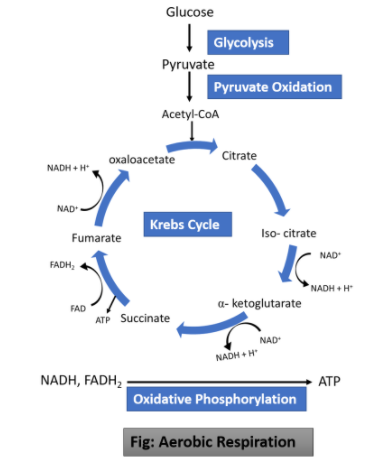
Answer
471.3k+ views
Hint: Aerobic respiration is an enzyme-catalyzed reaction which can be grouped into begins with glycolysis in the cytosol. This intermediate is formed only when the cell has decided to be committed to aerobic respiration.
Complete answer:
After the formation of pyruvate from glucose via glycolysis in cytosol, a cell can take two different cycles depending upon the availability of oxygen. In the presence of oxygen, further oxidation of pyruvate occurs in the mitochondrial matrix. Pyruvate is transported from the cytosol to the mitochondrial matrix with the help of a transport protein, where it is oxidized to acetyl-CoA. This conversion of acetyl CoA is catalyzed by a highly organized multienzyme complex called pyruvate dehydrogenase complex.
Additional Information:
In the overall reaction, carbon dioxide is removed from the carboxyl group of pyruvate and the two carbons remain reacts with CoA( Coenzyme A) to form acetyl CoA. This reaction is collectively known as oxidative decarboxylation of Acetyl-CoA. Also, the highly exergonic nature of the reaction makes it highly irreversible that is once Acetyl-CoA is formed, the cell is committed to entering the next step in respiration which is Kreb’s cycle or TCA cycle( Tricarboxylic Acid Cycle). It occurs in the mitochondrial matrix.
In the Krebs cycle, Acetyl-CoA is accepted by ‘oxaloacetate’ a 4-carbon molecule to produce the first product citrate, a 6-Carbon molecule. The net result of the Kreb cycle is that for each acetyl group entering the cycle as acetyl CoA, two molecules of carbon dioxide are released along with energy. All three steps - glycolysis, pyruvate oxidation, and Krebs cycle, releases energy from the glucose molecule in the form of ATP, NADH, and ${ FADH }_{ 2 }$.

So, the correct answer is ‘Acetyl-CoA’.
Note: The free energy released in the form of NADH and ${ FADH }_{ 2 }$ needs to be converted to usable forms of energy i.e ATP, which can be used by the cell. Electrons are transferred from NADH and ${ FADH }_{ 2 }$ through a series of electron carriers present on the inner mitochondrial membrane. This is described as oxidative phosphorylation or in common terms electron transport chain(ETC).
Complete answer:
After the formation of pyruvate from glucose via glycolysis in cytosol, a cell can take two different cycles depending upon the availability of oxygen. In the presence of oxygen, further oxidation of pyruvate occurs in the mitochondrial matrix. Pyruvate is transported from the cytosol to the mitochondrial matrix with the help of a transport protein, where it is oxidized to acetyl-CoA. This conversion of acetyl CoA is catalyzed by a highly organized multienzyme complex called pyruvate dehydrogenase complex.
Additional Information:
In the overall reaction, carbon dioxide is removed from the carboxyl group of pyruvate and the two carbons remain reacts with CoA( Coenzyme A) to form acetyl CoA. This reaction is collectively known as oxidative decarboxylation of Acetyl-CoA. Also, the highly exergonic nature of the reaction makes it highly irreversible that is once Acetyl-CoA is formed, the cell is committed to entering the next step in respiration which is Kreb’s cycle or TCA cycle( Tricarboxylic Acid Cycle). It occurs in the mitochondrial matrix.
In the Krebs cycle, Acetyl-CoA is accepted by ‘oxaloacetate’ a 4-carbon molecule to produce the first product citrate, a 6-Carbon molecule. The net result of the Kreb cycle is that for each acetyl group entering the cycle as acetyl CoA, two molecules of carbon dioxide are released along with energy. All three steps - glycolysis, pyruvate oxidation, and Krebs cycle, releases energy from the glucose molecule in the form of ATP, NADH, and ${ FADH }_{ 2 }$.

So, the correct answer is ‘Acetyl-CoA’.
Note: The free energy released in the form of NADH and ${ FADH }_{ 2 }$ needs to be converted to usable forms of energy i.e ATP, which can be used by the cell. Electrons are transferred from NADH and ${ FADH }_{ 2 }$ through a series of electron carriers present on the inner mitochondrial membrane. This is described as oxidative phosphorylation or in common terms electron transport chain(ETC).
Recently Updated Pages
Fill in the blanks with suitable prepositions Break class 10 english CBSE

Fill in the blanks with suitable articles Tribune is class 10 english CBSE

Rearrange the following words and phrases to form a class 10 english CBSE

Select the opposite of the given word Permit aGive class 10 english CBSE

Fill in the blank with the most appropriate option class 10 english CBSE

Some places have oneline notices Which option is a class 10 english CBSE

Trending doubts
Fill the blanks with the suitable prepositions 1 The class 9 english CBSE

How do you graph the function fx 4x class 9 maths CBSE

Which are the Top 10 Largest Countries of the World?

What is the definite integral of zero a constant b class 12 maths CBSE

The Equation xxx + 2 is Satisfied when x is Equal to Class 10 Maths

Differentiate between homogeneous and heterogeneous class 12 chemistry CBSE

Define the term system surroundings open system closed class 11 chemistry CBSE

Full Form of IASDMIPSIFSIRSPOLICE class 7 social science CBSE

Change the following sentences into negative and interrogative class 10 english CBSE




